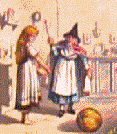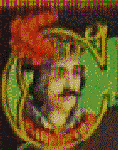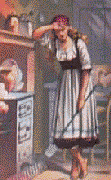Perrault's Durable Myth Cinderella: WestCiv Female Role Model Propaganda
|
Cinderella was a folktale older than the polished early 18th-century version fairy-tale of Perrault. He got rid of some peasant bloody-mindedness, emphasized fashion notes, and produced a slick tale popular (in France and England) in nurseries of the nobility and of the emerging rich bourgeosie. You can review the Perrault version (in a London 1729 English translation) that lets you switch to several 19th and early 20th century versions (through about 1914) for each episode at The Cinderella Project, where students of computer library science made etexts of some old books from a children's book collection. The value discussion, below, of Perrault's durable myth, that has lasted from the Age of Reason to the Age of Corporate, Consumer Capitalism, will be used in comparing the creative changes -- which reject all these values -- in the story as revisioned by a Mi'kmaq storyteller, with a Penobscot add-on, sometime in the mid-19th century. There are more than 3,000 stories that folklorists ID as "Cinderella variants" worldwide; almost every culture, every nation, has some -- native-borrowings by indigenous storytellers who use some of the themes, and some of them more indigenous -- with different cultural values embodied, as in the case of the Mi'kmaq story. Find out about some of these versions currently in print as children's stories at The Children's literature Cinderella page maintained by Prof. Brown of the University of Calgary.
The peasants were more bloody-minded than elegant Perrault wanted. In the older folktale version, the elder sisters cut off toes and bunions, filling the glass slipper with blood, in an effort to jam feet into it. Too, the peasant ending has bloody revenge worked on the stepmother and stepsisters -- by the king, not the prince or Cinderella, who are off living happily ever after. The king is angry bcause his royal orders to present all nubile maidens at the ball (for the prince's choice) were disobeyed, and the stepmother and sisters also tried to prevent Cinderella from trying on the slipper, contrary to his royal proclamation. So his torturers force them to dance themselves to death, wearing red-hot iron "boots" -- a popular torture implement of the time in the dungeons of nobility and Church. This final revenge aspect is omitted. The Victorian versions grow ever more saccarine, with the stepmother and sisters becoming just as sweet as Cinderella, once she ensconces them nobly in her new castle. Why are versions of Perrault's myth so durable -- lasting almost 300 years beyond the origin, to countless children's versions for the 20th century, TV cartoons, Disney versions, computer software, and modern versions for escape reading -- Harlequin Romances -- for young adult women of the working class? Certain values built into Perrault's version, carried forward through the centuries, have given the story this endurance. It is a teaching tale for young women. It teaches first that for "proper" young women -- those who may aspire to the nobility, attract The Man -- the proper thing to do is whatever's wanted of you however unpleasant, unreasonable. To be "nice" is to be docile and servile to those with power, wicked stepsisters, a stepmother bent on ousting you from dowry and inheritance rights. Don't annoy Big Daddy with sad stories of your oppression. Smile sweetly and iron the ruffles on those dancing clothes for the dance you won't be allowed to go to. The second lesson is an outgrowth of the desired feminine docility, servility. There is nothing Cinderella can do to change her unpleasant situation, to get a fair deal within her newly-expanded family. Nothing she could do that would leave her sweet, docile, servile character in place. She has no other character actually; she is defined by physical beauty (hidden in rags and ashes) and servile sweetness. She has no initiative, no imagination, no strength, no cleverness, nor even anger; only a kind of silent, hidden sadness at the abuse she willingly, docilely, puts up with. She is a wimp all the way, and "proper" young women are supposed to be smiley wimps like that. It takes a Fairy Godmother -- an intrusion of magic, of something unnatural to the rationalist world of the 18th century -- to change Cinderella's situation. Not only is her personal character inadequate to do anything on her own, to change her situation. The change needed demands money, lots of money, to which she (as a proper female) has no access or control. Even if she were to make her own way to the castle, to the ball every maiden in the kingdom is supposed to attend, dressed shabby, not delivered in a chauffered limo, and without servants, she might not be admitted to the palace. If she was let in, looking poor, without expensive clothing (personal body servants had to get upper-class women into their clothes in those days, corset lacing and fasteners couldn't be managed by the wearer), expensive jewelry, and expensively-treated and dressed hair or wig, expensive makeup job, she could never have attracted the Prince at all. Women of the poor, or dressed poor (her father is clearly rich), are invisible to rich men looking for wives. She is completely dependent on an irrational magic that no rational adults actually believed in -- they called it 'the Age of Reason' that they were living in, after all. Women, though, were supposed to be irrational beings in this and every age. So, out of nowhere. comes the Fairy Godmother. From a disbelieved realm of nonexistent powers. As the pix below show, she magics the pumpkin and household vermin into the equivalent of a powerful limo (horse-drawn fancy coach, coachman, footmen). By this same disbelieved magic, no efforts of her own, Cinderella is given costly couture ball gown, jewels, and a makeup makeover. The Fairy Godmother is money, personified. To buy the right stuff -- goods, personal services. This -- in modern version -- would be a sort of 'buy on credit' or 'rent temporarily' deal. Everything reverts when the rent-period is up, or you can't continue the payments, midnight. In the third pic, we see this happening. Cinderella, drifting and dreaming in the Prince's arms, lost track of the time, had to flee (losing one glass slipper), as her dress reverts to rags, the coach and horses to pumpkin and mice. | ||
|---|---|---|
 |
 |
 |
|
The operative values of this durable myth-for-women, even in modern industrial-capitalist society are: You are dependent, you need to be small and weak (dainty), have physical beauty, and the consumer-trappings money can buy to make that beauty visible to others. Above all, be docile, servile, nice, don't make a fuss -- and perhaps The Man will take you up. In modern versions of the myth, the Fairy Godmother (Mme Neiman-Marcus) is even less plausible to working girls than in the European Age of Reason. So in the modern versions of this tale for young women, The Man usually recognizes Cinderella despite her drab attire as a waitress, store clerk, or whatever non-rich station she inhabits while waiting to be taken up by The Man. The values of the Mi'kmaq storyteller, reworking this durable capitalist-consumer docile female myth, were almost the opposite. As we'll see, these Native storytellers were telling a cautionary tale. If you've read the Mi'kmaq story, let's now compare these myths -- European vs. Native. Judy Sierra: Cinderella Worldwide Book, Oryx Multicultural Folktales Seeries. Oryx Press. Contains Invisible One from 1914 Red Indian Fairy Book version, 24 variants of the Cinderella story as told from ancient Egypt, China, Russia, etc. Link-to here a press catalog description, Sierra's preface, and a sample chapter (not on Invisible One). Cinderella Stories -- a page of references to many variants world-wide by Canadian Children's Lit professor R. Brown. Cinderella Project -- Students of e-librarying transcribed a number of old versions of Cinderella, available on-line; this is their homepage for the project. | ||
Navigation Buttons  TOP of page
TOP of page
START |
Myths |
Version |
Menu |
MENU |
|---|


 It is well known -- an astonishment (and disappointment) of my childhood -- that the "glass slipper" image and theme was not in the original peasant version that Perrault polished to his literary version. The peasants said Cinderella had footgear of vair or fur, but even before Perrault, tellers had changed this to verre, glass. Mukluks wouldn't have been too elegant, peeping out under a ballgown of cloth of gold. Once the slipper had become delicate, gleaming (and foot-killer) crystal, the incident of Cinderella's running off and losing it, so that the lost slipper is used to "find" her (because only her dainty foot can fit into it) was added. Mukluks wouldn't fall off, dancing or running.
It is well known -- an astonishment (and disappointment) of my childhood -- that the "glass slipper" image and theme was not in the original peasant version that Perrault polished to his literary version. The peasants said Cinderella had footgear of vair or fur, but even before Perrault, tellers had changed this to verre, glass. Mukluks wouldn't have been too elegant, peeping out under a ballgown of cloth of gold. Once the slipper had become delicate, gleaming (and foot-killer) crystal, the incident of Cinderella's running off and losing it, so that the lost slipper is used to "find" her (because only her dainty foot can fit into it) was added. Mukluks wouldn't fall off, dancing or running.